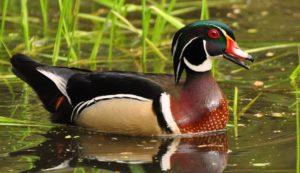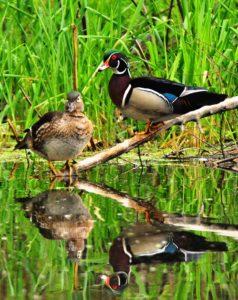Photography courtesy of Lowell Washburn, all rights reserved.
A nearly impenetrable fortress of mature oak, wild grape, and dense gooseberry has helped to keep Bill’s pond a well-kept secret. Small but mighty, the shallow wetland is barely twenty yards in width and is well punctuated with a mix of emerging sedges, river bulrush, and floating duckweed. For nesting wood ducks, Bill’s pond is nothing short of paradise.
Migrating wood ducks arrive on Bill’s pond by early April each year. Since female wood ducks have an uncanny desire to return to the place of their birth, many of the spring arrivals are repeat visitors. Mates are acquired on the southern wintering grounds and adult hens, along with last year’s surviving daughters, arrive paired up and ready to nest.
Elegant in design, wood ducks are the Beau Brummel of waterfowl. With striped head crest and iridescent feathering, they possess the most stunningly colorful plumage of any duck. They are also one of the few waterfowl species that nest in trees rather than on the ground. Following their spring arrival, pairs waste little time before scouring the woodlands for suitable nesting cavities. Where natural cavities are scarce, hens will readily accept artificial nest boxes as a viable substitute. A hen may inspect dozens of cavities before selecting the one she considers to be “just right”. The duck will then lay one egg per day until her clutch is complete. On a good year, Bill’s pond may provide nesting headquarters for a dozen or more wood duck pairs. Three of those hens occupy wooden nest boxes; the remainder resides in natural tree cavities.
On days when I visit the pond, I arrive at least a full hour before sunrise. After quietly installing a portable ground blind I simply crawl in, drink coffee, and wait for the show. The wait is usually a short one as pairs begin sailing in from larger marshes while it is still dark.
Although important, seclusion is not the only attraction. Bill’s pond is rich in invertebrate insect life. Following their noisy splash downs, hens immediately began probing the pond’s oozy bottom where they find and guzzle the protein laden bugs needed for egg production. Sticking to a more plant based diet; the accompanying drakes rarely venture more than a few inches from their foraging mates.
Wood ducks are blessed with an amazingly diverse vocabulary. Although most people are familiar with the screeching alarm call of the female, very few have opportunity to hear the rest of the wood duck’s vast repertoire of chatters, peeps and a wide variety of sounds that just cannot be adequately described. Although the drakes are equally as chatty – and maybe even more so — than the hens, their voices are so incredibly soft that the whispering vocalizations can only be heard for a distance of several feet. Listening to multiple wood ducks pairs as they enthusiastically communicate among themselves provides a rare and fascinating outdoor experience.
By the time it’s light enough to run a camera, it is likely that at least a few birds will already be foraging [and communicating] at close range. The show only gets better as new birds continue to arrive. But once the sun climbs above the horizon, pairs quickly shift gears and began lifting off to fly to adjacent timber where they resume the search for potential nest sites. If the understory is thick enough to screen movement, a person can sometimes follow to see where birds go.
Unfortunately, some hens are currently making their second nesting attempt of the year; the first clutch already lost to raccoons or fox squirrels which – next to bulldozers and chainsaws – are a nesting wood duck’s worst enemies. But many nests will survive, and later this month successful females will suddenly appear at water’s edge followed by their boisterous brood of newborn fuzz balls. It’s an exciting moment as a brand new generation of wood ducks begins life at Bill’s pond.







 Tom Cope
Tom Cope Sue Wilkinson
Sue Wilkinson Susan Judkins Josten
Susan Judkins Josten Rudi Roeslein
Rudi Roeslein Elyssa McFarland
Elyssa McFarland Mark Langgin
Mark Langgin Adam Janke
Adam Janke Joe Henry
Joe Henry Kristin Ashenbrenner
Kristin Ashenbrenner Joe Wilkinson
Joe Wilkinson Dr. Tammy Mildenstein
Dr. Tammy Mildenstein Sean McMahon
Sean McMahon